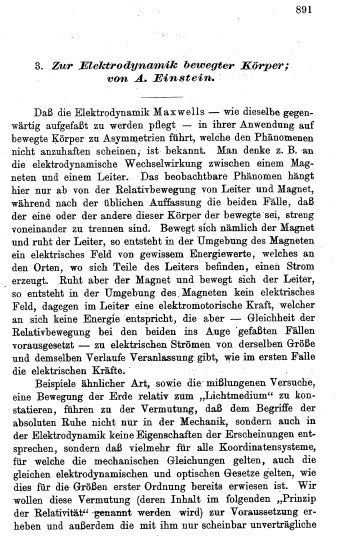 “If, for example, I say that ‘the train arrives here at 7 o’clock,’ that means, more or less, ‘the pointing of the small hand of my clock to 7 and the arrival of the train are simultaneous events.'” –Albert Einstein
“If, for example, I say that ‘the train arrives here at 7 o’clock,’ that means, more or less, ‘the pointing of the small hand of my clock to 7 and the arrival of the train are simultaneous events.'” –Albert Einstein
The special theory of relativity has the reputation of being nearly impenetrable, as opposed to the general theory of relativity, which has the reputation of being wholly impenetrable. But Albert Einstein had a knack for explaining complex ideas: Make them simple enough that even a child could understand them. And a child, in this case, was anyone old enough to know what the time is when the small hand is pointing precisely to the 7.
“On the Electrodynamics of Moving Bodies” is a model of a scientist walking his readers through his thought process. The paper famously contains no citations; we are inside a mind, present at the moment of creation. “It is well known,” the paper opens, laying out what the writer thinks the reader needs to know in order to understand the argument to come. Today that “It is well known” would need a few citations—the papers to which readers can turn for a refresher course on what’s well known, or at least upon which the original authors can build an academic record based on how many times their work has been cited. But no such niceties were necessary in 1905. Einstein tells the reader what’s well known (what it is, isn’t relevant here) in three introductory paragraphs. Then he gets down to business: When we’re over here, how do we know what time it is over there?
The paper is theoretical, but its roots are practical. The world had recently moved from mechanical clocks to electrical clocks. Unlike mechanical clocks, electrical clocks allowed the transmission of information from town to town, city to city, capital to capital, even ship to shore once radio signals came into use—and all at the speed of light.
The speed of light as a factor in the transmission of information was still a relatively new concept. “I have looked further into space than ever human being did before me,” the astronomer William Herschel had written less than a century earlier, in 1813. Over the four decades preceding that declaration Herschel had built more and more powerful telescopes, allowing him to push his observations to greater and greater depths across the universe, and now the implications of that progress were beginning to dawn on him: “I have observed stars of which the light, it can be proved, must take two million years to reach the earth.” The night sky was turning into a time machine.
Einstein, however, reversed the trajectory in that thinking. Instead of considering the implications of looking farther and farther across the universe and thereby deeper and deeper into the past, he thought about the meaning of looking nearer and nearer—or, by the same reasoning, closer and closer to the present. Look near enough, he realized, and you’ll be seeing very close indeed to the present. But only one place can you claim to be the present—and then only your present. And that place is the face of your clock.
“If, for example, I say that ‘the train arrives here at 7 o’clock,'” Einstein writes in that paper, “that means, more or less, ‘the pointing of the small hand of my clock to 7 and the arrival of the train are simultaneous events.'” That seemingly casual “more or less” is crucial. Whatever distance separates your timepiece from the train is a measure of how far in your past the arrival of the train is. For that matter, the timepiece is in your eyeballs’ past. And the photoreceptors in your eyeballs are in your neuron-firing brain’s past. But as Einstein said, for the sake of his argument we can leave those subtleties aside.
Still, that kind of reasoning was crucial in reconceiving time, as Einstein knew from personal experience. The historian of science Peter Galison has pointed out, first in his essay “Einstein’s Clocks: The Place of Time,” then in his book Einstein’s Clocks, Poincaré’s Maps, that in his day job Einstein “was chiefly charged with the evaluation of electromagnetic patents. Standing at his wooden podium he, like the other twelve or so technical experts in the patent office, methodically went through each submission, searching for the principles that lay at its core.” He would have routinely come across patent applications for components of clock-coordination systems.
Einstein wasn’t alone in recognizing the need to reconceive time. One of the greatest influences on Einstein’s thinking, the French mathematician and philosopher Henri Poincaré, often wrote and lectured about the topic. Poincaré was a member of the Bureau des Longitudes in Paris and a professor at the École Professionelle Supérieure des Postes et Télégraphes; in both capacities he had to attend to the coordination of electrical clocks. In his highly influential 1898 essay “La Mesure du Temps” (“The Measure of Time”), he wrote that a geographer or navigator wanting to know the time in Paris without being in Paris could rely on the transmission of a telegraphic signal. “It is clear that the reception of the signal at Berlin, for instance, is after the sending of the same signal from Paris,” he wrote. “But how much after? In general, the duration of the transmission is neglected and the two events are regarded as simultaneous.” But, as Poincaré knew, they aren’t simultaneous, and if you wanted to coordinate the clocks of the world, you had to take the discrepancies into account.
The Dutch physicist Hendrik Antoon Lorentz also was working on the problem. Unknown to Einstein, Lorentz had recently arrived at similar equations as the ones that Einstein reached in his paper. But in his conception, Lorentz’s equations described physical changes that objects approaching the speed of light would undergo—the slowing of the clock’s hands, the shortening of the rod’s length. In a sense, Lorentz was adopting the point of view of the object. As it approaches the speed of light, what is it really? The answer: slower, or shorter.
Einstein, however, was seeing the object from the observer’s point of view. His equations described perceptual changes that an observer would experience: the slowing of the clock’s hands, the shortening of the rod’s length. The same would be true from the clock’s or rod’s point of view, so to speak: The observer would be the one whose time was slowing and length was shrinking. Who would be right? Both—or more accurately, either, depending on who’s doing the measuring. How much time is passing really? How much is the rod shortening really? The answer: There is no “really.” There is only the information that the observer perceives through the transmission of electromagnetic radiation, i.e. light, and that information defines reality for the observer, because that information is all that the observer can ever perceive.
So why was Einstein the one to take “the step,” as he called it? In his obituary for the Austrian physicist and philosopher Ernst Mach, another great influence on his thinking, Einstein hazarded a guess. “It is not improbable that Mach would have discovered the theory of relativity,” he wrote, if the constancy of the speed of light had been a concern among physicists “at the time when his mind was still young and susceptible.”
Maybe youth and its attendant freedom from preconceptions did make the difference. Mach was 67 when Einstein wrote his relativity paper, and Poincaré and Lorentz were in their early 50s. Einstein had just turned 26. But I suspect that what distinguished Einstein was a quality perhaps related to youth, but also perhaps timeless: the ability to take the information approaching him at the speed of light, and to see it through the eyes of a child.
* * *
Translation credits: “On the Electrodynamics of Moving Bodies,” The Collected Papers of Albert Einstein, Volume 2, The Swiss Years: Writings, 1900-1909 (Princeton: Princeton University Press, 1989), translated by Anna Beck, in consultation with Peter Havas; “The Measure of Time,” The Foundations of Science: Science and Hypothesis; The Value of Science; Science and Method (Washington: University Press of America, 1982 [reprinted from 1913, 1946]), translated by George Bruce Halsted.


One thought on “Relativity for Preschoolers”
Comments are closed.